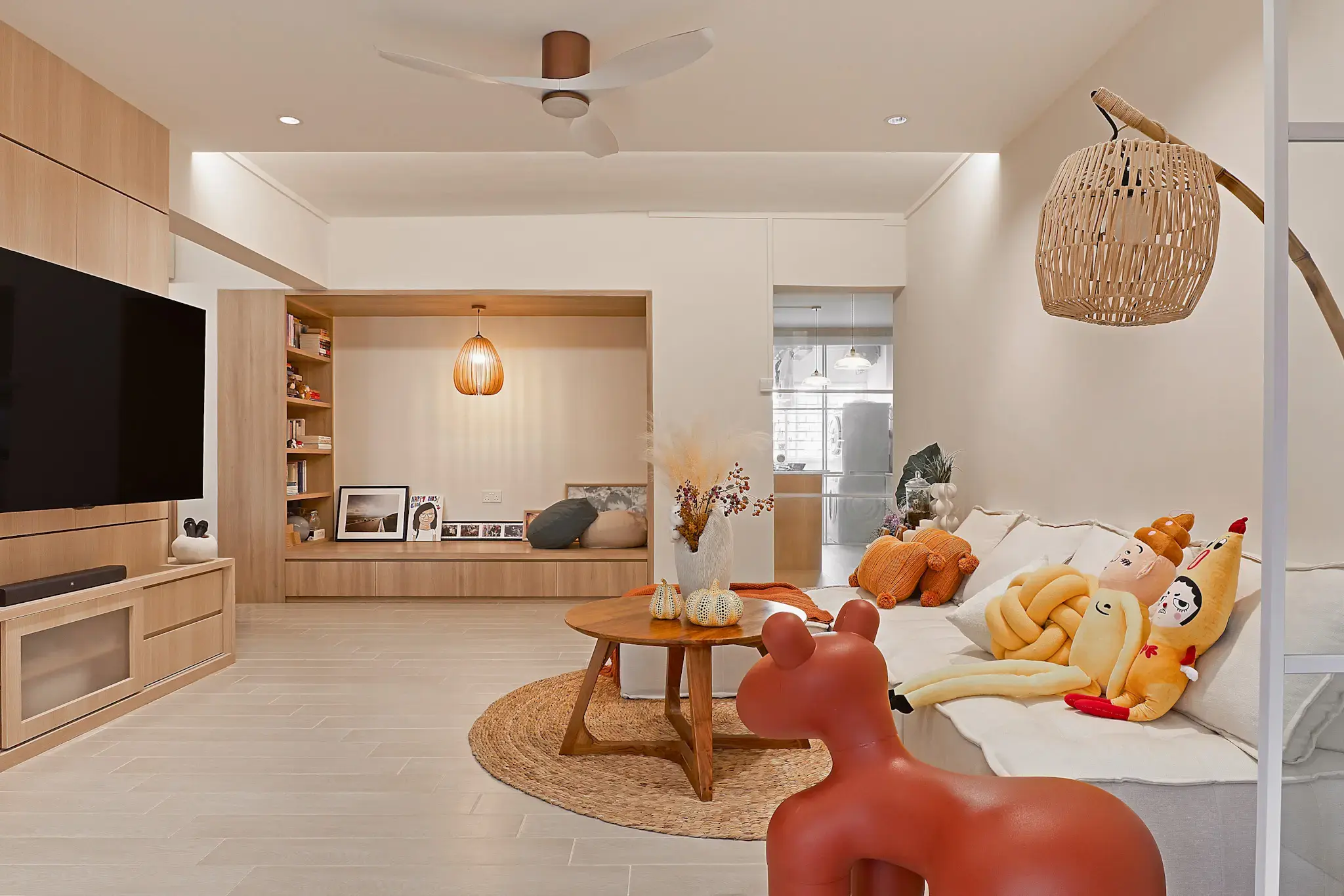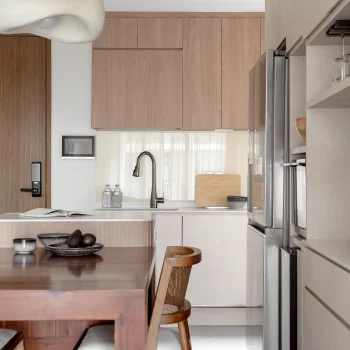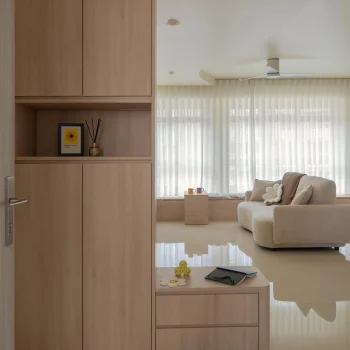Key Takeaways:
- Warm minimalism is in: earthy neutrals + tactile finishes = an inviting living space with tidy clean lines.
- Biophilic + smart tech fusion: expansive windows, vertical greenery, and AI lighting create smooth integration of nature and convenience.
- Collaborative fun: from single-wall sketches to hero pieces, Playground’s interior designers turn dreams into stunning design—minus the stress.
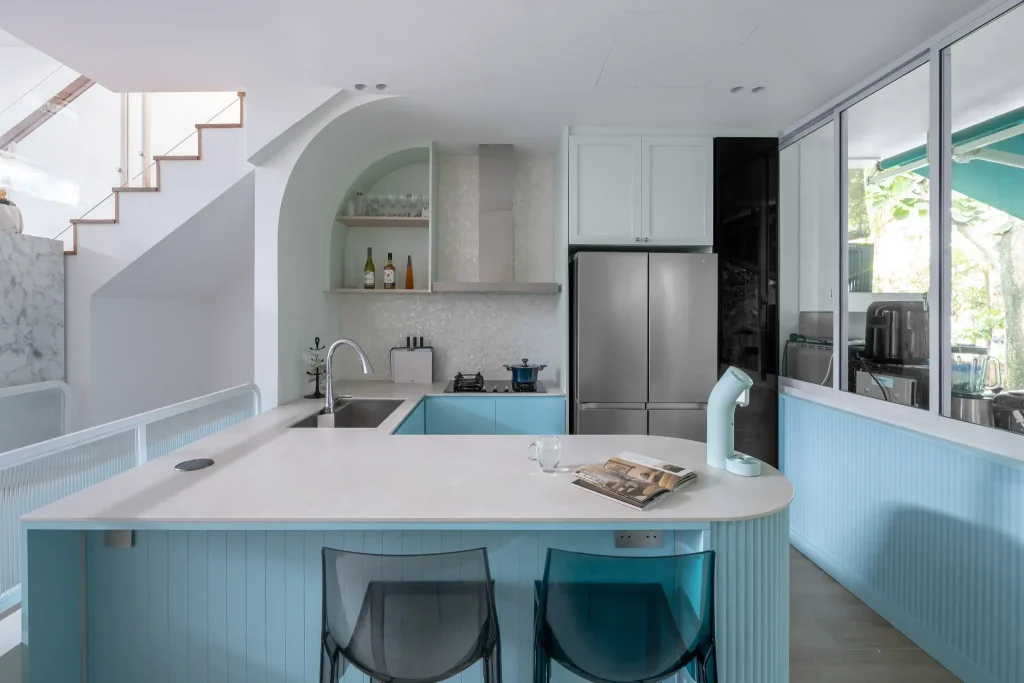
The Playground Story
Founded in 2018, Playground is a group of enthusiastic designers who believe great interior design should feel like a joyful game. We treat every project—from cosy BTO flats to sprawling landed homes—as a modern contemporary interior adventure, brainstorming alongside you so the final space reflects your lifestyle, quirks, and dreams.
Our studio’s ethos is simple: design the way you live. We laugh through colour trials, debate center-table heights, and celebrate when contemporary interiors come together with lasting sophistication. That playful spirit explains why clients see us as collaborators rather than contractors.
What Defines Modern Contemporary Interior Design
Modern refers to the ever-evolving marriage of present-day design trends and mid-century principles. Unlike purely modern interior design, which is rooted in the 1950s, contemporary design style adapts, absorbing current trends such as curved forms or smart/circadian lighting while keeping clean lines and open spaces.
The most prominent characteristics include crisp linear profiles balanced with gentle curves, a neutral colour palette foundation accented by striking accents, and a focus on natural light, natural elements, and forward-thinking solutions. In other words, contemporary interiors stay fresh because they’re constantly evolving. Modern interior design refers to a specific mid-century period, whereas modern contemporary interior embraces current trends, making contemporary interior design the choice for homeowners who want spaces that evolve alongside modern lifestyles.
Key Characteristics of Contemporary Interiors
When we analyse contemporary interiors across Singapore, several key characteristics emerge: uncluttered plans, large windows, ample natural light, and furniture with simple silhouettes. These elements foster a sense of openness that makes even a compact condo feel generous. Within these contemporary interiors, interior design decisions focus on creating open spaces where modern contemporary interior design principles, such as low-profile furniture and concealed storage, allow the space to breathe and highlight the design style’s preference for functionality over fuss.
Equally important are materials—think sintered-stone counters, matte metal lighting features, and raw natural textures like rattan. These design elements epitomise contemporary design style, proving that contemporary interiors can marry modern aesthetics with timeless elegance while still meeting the practical demands of Singapore homes.
Warm Minimalism: The New Neutral
Contemporary interior design in 2025 has traded sterile white boxes for warm minimalism. We now layer neutral hues such as caramel brown and olive green over neutral walls, pairing them with natural materials like wood slats to craft a contemporary space that feels lived-in—not showroom cold.
Clean lines still reign, but we soften them with textured limewash or microcement. The result introduces subtle depth while staying within the contemporary theme and maintaining the overall aesthetic of calm sophistication.
Biophilic Design in the Tropics
Singapore’s humid climate begs for greenery, so contemporary interiors here lean into biophilic design. Vertical greenery climbs shelving systems, frameless pivot doors open to pocket gardens, and built-in planters define dining area banquettes.
These natural elements not only support wellbeing and a connection to nature but also blur boundaries between indoors and outdoors, creating a contemporary home that feels connected to nature even in high-rise living.
Embracing Daylight and Large Windows
HDB window replacements: large windows channel natural light deep into the living space, reducing reliance on artificial sources and enhancing neutral colours. Our designs often replace solid walls with sliding glass (condo-only; HDB flats must follow Window Works rules) panels, ensuring smooth balcony-to-lounge integration. Any must use BCA‑approved window contractors listed with HDB.
In BTO flats where façade constraints exist, we deploy mirrors and strategic lighting features to bounce ample natural light, making compact rooms appear brighter and more expansive.
Clean Profiles and Sleek Lines
Straight lines guide the eye and organise space, so we repeat them in cabinetry grooves, ceiling rail lighting, and feature walls. Using the same geometry twice achieves rhythm—Repeating linear elements (e.g., grooves or lighting) create rhythm without visual clutter. without visual clutter.
To prevent rigidity, we insert streamlined lines in metal trims and slim furniture legs, balancing geometry with comfort for a contemporary dining room or welcoming space alike.
Curved Forms and Organic Materials
Curved counters, arched doorways, and oval side tables add softness that counterbalances clean lines. These gentle sweeps encourage flow, reduce hard corners, and echo Singapore’s garden-city philosophy.
When combined with earth-friendly materials such as bamboo or woven rattan, curves create contemporary interiors that feel both sophisticated and approachable. By weaving such curved furniture into contemporary style schemes, we create contemporary interiors that feel human-centred despite the clean lines that define modern aesthetics.
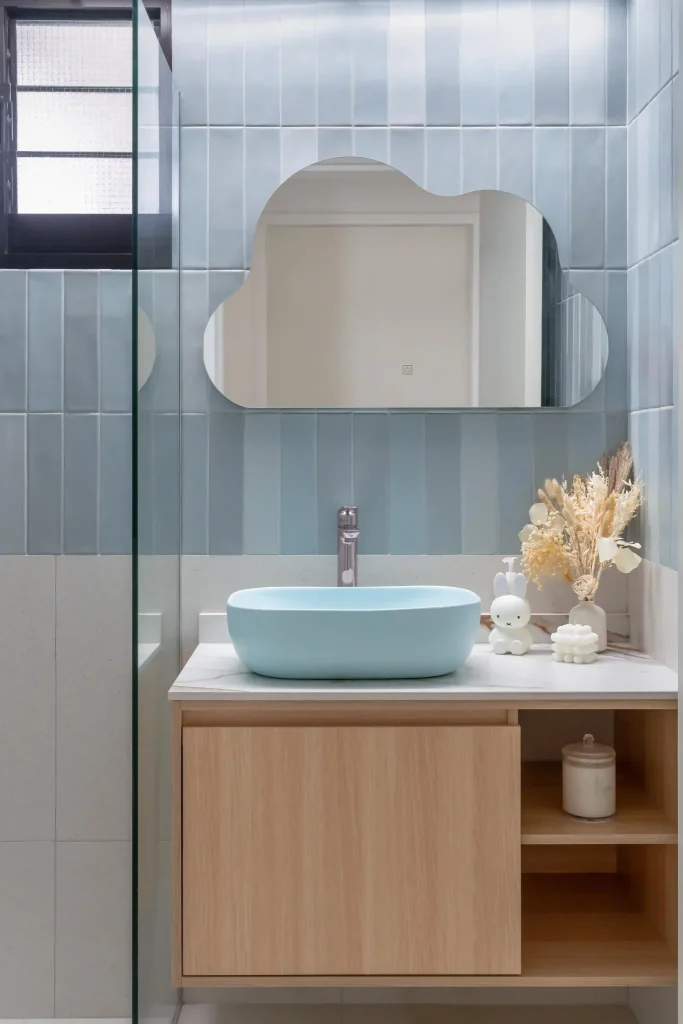
Smart Technology and Innovative Solutions
No modern contemporary interior is complete without innovative solutions. From AI-managed climate control to smart locks and automated doors (pivot-door automation is specialist and subject to building/MCST/HDB rules), tech hides within clean cabinetry, preserving the slim exterior while delivering 21st-century convenience.
Our favourite contemporary interior design ideas include wireless charging embedded into the accent table and smart blinds that adjust with daylight. These tech-forward solutions demonstrate how contemporary design style adapts to current trends without sacrificing the timeless elegance sought by clients across Singapore.
Textured Surfaces for Visual Interest
Microcement walls, limewash finishes, and fluted panels provide subtle shadows that adds visual interest without overcrowding the contemporary space. These textures catch natural light differently throughout the day, creating dynamic yet calm scenes.
Such surfaces echo the “wabi-sabi” appreciation for imperfect beauty, ensuring your interior design boasts a tactile depth rare in glossy, high-sheen rooms.
Colour Palettes: Neutral Hues with Bold Accents
Contemporary interiors love a neutral colour palette—think greige, taupe, and soft charcoal—punctuated by bold accents such as emerald dining chairs or a terracotta feature wall.
This neutral colors base allows homeowners to swap cushions, artwork, or other elements easily, keeping the design fresh as personal tastes evolve. For homeowners exploring contemporary interior design, such palettes provide an adaptable base; interior design professionals can then layer colour strategically, ensuring the space aligns with both modern contemporary interior aspirations and the subtler nuances of contemporary design.
Furniture and Statement Pieces
Contemporary furniture features simple silhouettes and clean lines, yet makes room for sculptural statement pieces like a geometric center table. We often mix low-profile sofas with slim contours and a single art-glass lamp to anchor the scene.
Remember, fewer but better pieces help the contemporary design shine; clutter undermines the spaciousness that defines modern contemporary interiors.
Dining Room Inspiration
A contemporary dining room prioritises flow. Open floor plans allow the dining area to merge with the kitchen, letting conversations travel alongside plates of chilli crab.
Pair upholstered dining chairs with straight legs for comfort and continuity, and suspend hanging lights above the table to highlight both food and friends.
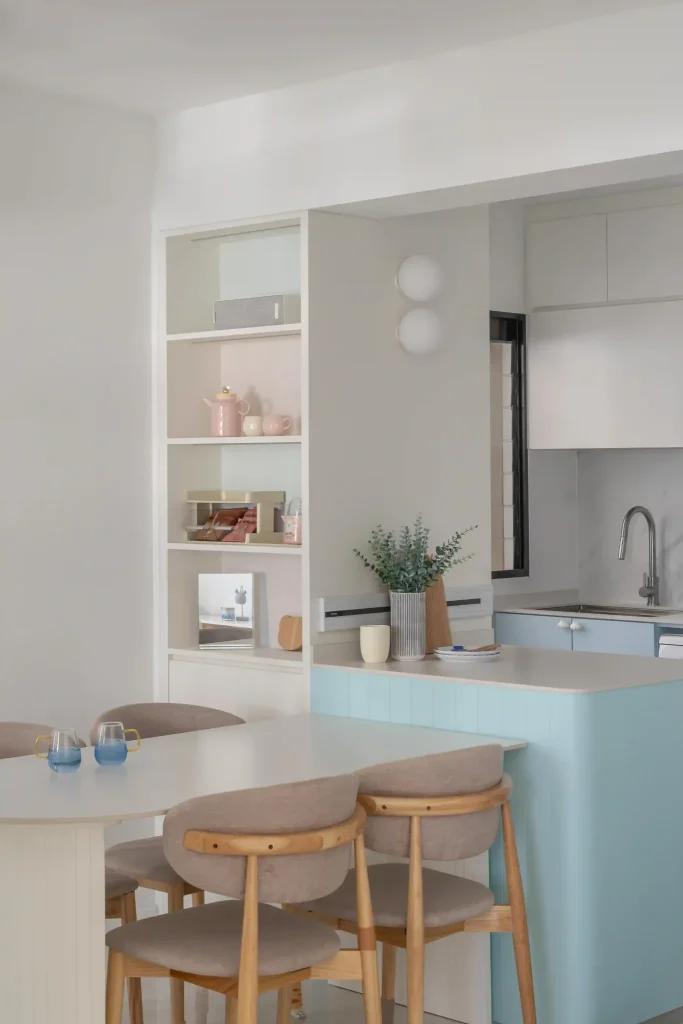
Contemporary Kitchen Essentials
The contemporary kitchen celebrates seamless cabinetry, handle-less drawers, and sintered-stone countertops that wrap around one wall before morphing into a breakfast bar.
Glass backsplash panels, concealed appliances, and ceiling rail lighting make maintenance easy while maintaining modern aesthetics.
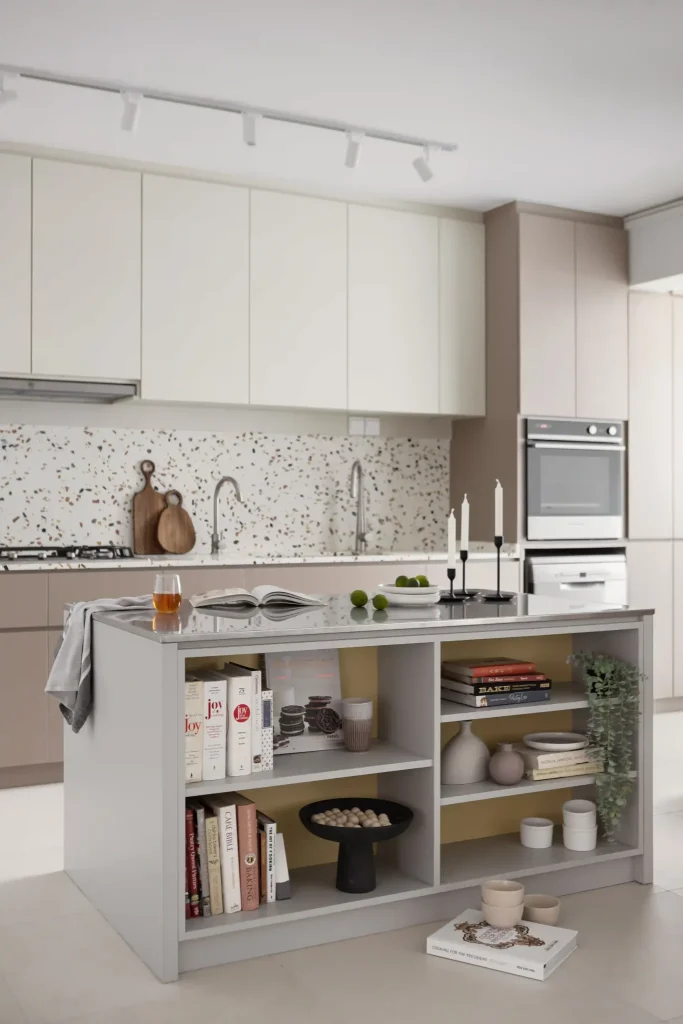
Living Space Layouts and Open Floor Plans
An open floor plan allows your living space to breathe, enhancing connection between lounging, dining, and cooking zones. By using a rug or low console to subtly define areas, we keep effortless flow without closing off sightlines. By keeping circulation clear, contemporary design champions spaciousness; this contemporary design style also leverages neutral colour palette foundations, allowing modern contemporary interior design accents to evolve as new design trends surface.
Curated contemporary décor—think a trio of vases repeating geometric shapes—creates cohesion while preserving flexibility for future rearrangements.
Bedroom Bliss: The Master Bedroom
In the primary suite, plush textiles meet clean lines. Neutral walls foster calm, while large windows invite morning sunlight. A simple accent table doubles as bedside perch, unifying style and function in a truly contemporary home sanctuary.
Lighting Strategies: Light Fixtures and More
Layered lighting is vital. Recessed downlights provide ambiance, sculptural lighting features create focal points, and accent lighting highlights artwork, while decorative lighting features in brass or matte black echo streamlined lines. Together, they turn everyday movement into theatrical moments.
For drama, we position a pendant cluster over the dining room table and slim LED strips beneath cabinets. Such modern contemporary lighting solutions ensure every corner gleams without glare.
Sustainable Materials and Practices
Sustainability now sits at the heart of contemporary design. We specify FSC-certified timber, recycled metal frames, and non-toxic paints, ensuring your ideal abode is kind to both inhabitants and planet. Specify SGBP/Green Label low‑VOC finishes; NEA bans formaldehyde in interior paints from 1 Jan 2026.
Choosing natural materials such as bamboo flooring or cork wall panels not only reduces carbon footprints but also delivers stunning design finishes that age gracefully.
Budget-Friendly Contemporary Interior Design Ideas
Good design style needn’t break the bank. Swap cabinet fronts instead of full carcasses, reuse existing side tables with new veneer, and add indoor greenery for instant life. These contemporary interior design ideas respect budgets while maximising impact.
Opt for contemporary décor like peel-and-stick wood slats or affordable statement pieces sourced locally. Small changes—say, installing dimmable lighting features—transform mood without hefty renovation bills.
Even within tight budgets, homeowners can achieve modern contemporary interior design flair by focusing on open spaces, neutral colours, and statement pieces that echo current trends. Select contemporary furniture with geometric shapes, pair it with a neutral color palette, and allow ample natural light to flood the zone. Such choices exemplify key characteristics of contemporary interior design while keeping costs transparent. Add decorative elements like monochrome art or sculptural planters to reinforce the neutral colour palette, yet introduce pops of colour that keep the space lively; such design elements are hallmarks of contemporary design that thrives on balance between restraint and personality.
The Playground Process: Designing Your Dream Home
Our interior designer team starts every project with a discovery session, mapping lifestyle patterns and key elements you can’t live without. From there, we sketch digital concepts, refine finishes, and specify contemporary furniture that suits both style and budget. Throughout this contemporary interior design journey, we repeatedly review design elements to ensure that contemporary interiors remain coherent, reflect your personal contemporary style, and incorporate modern interior design upgrades where helpful—think smart locks or voice-controlled lighting—without losing the warm character that defines Singapore’s most sought-after contemporary spaces.
Throughout construction we host site-walks, share progress videos, and, yes, crack jokes. Because building a contemporary home should feel like play—not pressure.
Ready to Start Your Design Adventure?
Let’s turn your Pinterest boards into reality. Book a complimentary consultation today, and discover how Playground transforms contemporary interiors into living, breathing playgrounds tailored just for you.
FAQ Section: Contemporary Interior Design
What are three characteristics of a contemporary design style?
Contemporary design is characterized by clean lines and minimalist aesthetics, emphasizing simplicity and uncluttered spaces. Neutral color palettes with bold accents form the foundation, typically featuring whites, grays, and beiges punctuated by vibrant colors for visual interest. Open floor plans and flexible spaces promote connectivity and adaptability, with fewer walls to create seamless flow between functional areas.
What is the difference between traditional and contemporary home design?
Traditional design features rich textures, ornate details, symmetrical layouts, and warm color palettes rooted in 18th-19th century styles. Contemporary design offers fresh, minimalist approaches with clean lines, neutral colors, and open spaces that reflect current trends. Traditional emphasizes classic furniture with curved lines and plush upholstery, while contemporary focuses on functional, streamlined pieces. Traditional creates timeless, refined atmospheres, whereas contemporary provides flexible, adaptable living spaces.
What colors are used in contemporary style?
Contemporary style primarily uses neutral color palettes including white, gray, beige, and black. Bold accent colors like deep blue, vibrant red, or rich green add character while maintaining sophistication. Current 2025 trends favor tranquil blues, earthy greens, warm terracottas, and muted pinks. Cool tones and stark contrasts are preferred, with contemporary design embracing both timeless neutrals and moody purples.
